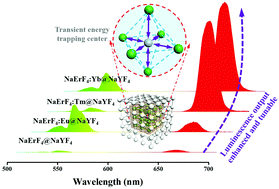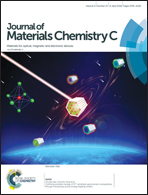Confining excitation energy of Er3+-sensitized upconversion nanoparticles through introducing various energy trapping centers†
Abstract
Luminescence concentration quenching significantly limits the upconversion (UC) performance of lanthanide-doped luminescent materials. Efficient confinement of the excitation energy in a lanthanide activator can alleviate the concentration quenching caused by cross-relaxation and energy migration to surface defects. In this work, a series of new energy trapping centers with varied migrating energy levels (2F5/2 of Yb3+, 3H5 of Tm3+, 5I6 of Ho3+, 7F6 of Eu3+, and 3F3 of Pr3+etc.) are introduced into NaErF4@NaYF4 nanoparticles. The results show that a great enhancement in Er3+ UC processes of converting multi-band NIR photons into visible emissions is achieved in NaErF4@NaYF4 after adding energy trapping centers. The energy level compatibility between Er3+ activators and the energy trapping centers determines the excitation energy confinement, energy-back-transfer efficiency and luminescence output. By incorporating the energy trapping center doped upconversion nanoparticles (UCNPs) into the TiO2 photoanode of dye-sensitized solar cells (DSSCs), the photon–electron conversion efficiency of DSSCs increases from 6.82% to 7.86% due to the improved multi-band NIR photon harvest of the TiO2 photoanode with NaErF4: 10% Yb@NaYF4.

- This article is part of the themed collections: Editor’s Choice: Progress in singlet fission and photon upconversion and International Year of the Periodic Table : Lanthanides for Precision Therapy and Beyond


 Please wait while we load your content...
Please wait while we load your content...